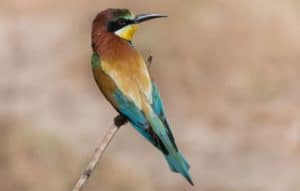Trip Details and Bird Highlights
Our first stop will be Arrocampo Reservoir, a superb wetland with possible bird highlights of Savi’s Warbler, Little Bittern, Great Reed Warbler, Penduline Tit, and Purple Swamphen. At the beginning of our trip, we will be staying near Trujillo, a town of medieval churches and renaissance palaces in Extremadura, for six nights. We will be visiting Monfragüe National Park’s enormous vertical rock faces and Mediterranean forest and meadow habitat. Griffon, Cinereous, and Egyptian Vultures will be easy to see at Salta del Gitano viewpoint, one of the main vista points of the park. Rock Sparrow and Black Redstart are usually around and a pair of Black Stork nest there as well. In this area, we will be looking for Bonelli’s Eagle (we’ll need some good luck to find) and Imperial Eagle in the park. Eagle Owl occurs nearby as well, so will likely return at sunset in hopes of spotting them.
On our first day in the plains, we will target both Great Bustard (Europe’s largest bird) and Little Bustard, Calandra and Greater Short-toed Lark and Black-bellied and Pin-tailed Sandgrouse. The steppe birds are often not easy to find, so we are trying for them in several areas during the trip. European Bee-eater and Spanish Sparrow are easy to see. We will also visit the best area in Extremadura (a western Spanish region bordering Portugal) for European Roller. Little Owl is around, but they will also take some time to find. Corn Bunting, one of Stefan’s personal favorites, will be abundant. Raptors are possible at any time, with Montagu’s Harrier patrolling the steppes, Short-toed and Booted Eagle high overhead, and all three vultures are again possible.
In the Jerte Valley, we will look for Lesser Spotted Woodpecker and Honey Buzzard near La Garganta de Los Infiernos. White-throated Dipper breeds along the creek, and we will also be in the right habitat for Spectacled Warbler. We will then climb to mid-level elevations near the tree line working on woodland birds before making our way back to the hotel.
Campo Lugar is another great little road for steppe species. Common Quail can be heard there in the morning as well. The Embalse de Sierra Brava may have a few waterfowl remaining, but Great Crested Grebe should be present.
The morning hours we will spend in the scrub uphill from Jaraicejo where the main target is Spectacled Warbler. Dartford Warbler, Iberian Gray and Woodchat Shrike should also be present. Red-legged Partridge also likes the area. Great Spotted Cuckoo will be our target for the next couple hours. Valdesalor Reservoir can be a good spot for shorebirds, but also Egyptian Goose and a variety of other species.
In Trujillo itself, we will look for Lesser Kestrel. Later in the evening, we can try for Scops Owl in Trujillo as well when it gets dark. On the way down to Doñana National Park, we will have one final chance at all the prairie species at the superb La Serena. This is probably the largest uncultivated area in Europe, with high populations of Montagu’s Harriers, sandgrouse, and bustards. The final area to hit for the day is the cute Sierra de Tiros. Black Wheatear is possible in the town of Benquerencia de la Serena. Also present in the rockscape of the cliffs are Blue Rock Thrush, Alpine Swift, and Red-billed Chough.
We will spend one whole day and the next morning at Doñana National Park, one of the major wetlands in Europe and a UNESCO World Heritage Site. Many European and African birds use its expansive salt marsh habitat. A half-day tour with a park guide will take us through a variety of different aquatic and forested habitats. We will finally see the coast with its gulls and terns. Slender-billed Gull will be a major target, and Greater Flamingo as well. If there is sufficient water, we should see a full set of wading birds, including Squacco Heron, Glossy Ibis, and a few shorebird species as well.
The Salinas de Bonanza are a great place for shorebirds, gulls, and waterfowl. Our main targets there, however will be Marbled Teal and White-headed Duck, both generally hard to find anywhere else in Europe. The area has a lot of potential for unusual birds, so who knows what we will find. At Chipiona will do a seawatch and then look for Little Swift, as there is a small colony near the harbor.
We will be driving from Andalucia to the Sierra de Gredos. The sierra will be our only access to high elevations during the trip. This includes the pinewoods at around 4000-5000 ft and the area above the tree line at over 6000 ft. We will be making a couple of shorter stops en route but hope to arrive in time to finish the day in the cool temperatures of a pleasant sierra evening. We will spend a lot of time near the Parador de Gredos looking for Citril Finch. Also in the surrounding pinewoods are Western Bonelli’s Warbler, Crested and Coal Tit, Gray Wagtail, Red Crossbill, Wood Lark, and Pied Flycatcher.
In the higher elevations of the Sierra, called the Platforma, we will be looking for the beautiful Rufous-tailed Rock Thrush, Bluethroat, Dunnock, Tawny Pipit, and Northern Wheatear. The wailing song of the Ortolan Bunting will be heard, and we will be spending several hours up there; this will involve a 1.5-mile uphill hike and then back down (hike roundtrip is 3 miles, 3 hours total). into the staggering beauty of the Iberian rockscape that you don’t want to miss. We have good chances of viewing the majestic Iberian Ibex here.
An abundance of birds, wildlife, wondrous landscapes, and a rich cultural heritage await you in Spain. We hope you join us for this unique ecotour to the wild, unknown corners of this incredible country!













